Tree Mortality and Swamps, Oh My!
 Environmental Science professor Dr. Wendy Robertson researches the soil moisture in southeastern Michigan forests following emerald ash borer invasions. When trees die from natural processes like fire and old age, new trees adapt and grow from the leftover nutrients. However, when trees die relatively quickly compared to their natural rates, forests have a hard time adjusting to such change. The emerald ash borer (EAB) is an invasive beetle species that is native to Asia. The insect now resides in 32 U.S. states and threatens over 8 billion ash trees in domestic forests. Under Dr. Robertson’s supervision, a group of undergraduate environmental science students examines the soil levels around white ash trees that were killed by EAB. While there is a lot of research on EAB, there is not much on how it could affect the hydrological cycle.
Environmental Science professor Dr. Wendy Robertson researches the soil moisture in southeastern Michigan forests following emerald ash borer invasions. When trees die from natural processes like fire and old age, new trees adapt and grow from the leftover nutrients. However, when trees die relatively quickly compared to their natural rates, forests have a hard time adjusting to such change. The emerald ash borer (EAB) is an invasive beetle species that is native to Asia. The insect now resides in 32 U.S. states and threatens over 8 billion ash trees in domestic forests. Under Dr. Robertson’s supervision, a group of undergraduate environmental science students examines the soil levels around white ash trees that were killed by EAB. While there is a lot of research on EAB, there is not much on how it could affect the hydrological cycle.
The Hydrologic process is a continuous cycle by which water is purified and transported from the earth’s surface to the atmosphere. Dr. Robertson and her team rely on field data and surveys to evaluate the changes in soil moisture and temperature. The results of the research indicate that a minimum threshold of white ash overstory (uppermost canopy layer in a forest) is likely necessary for the ash mortality to affect soil moisture content. Field research shows that gaps in a forest’s canopy (left by dead trees) can leave the soil near river banks vulnerable. The soil where trees were killed by EAB holds more moisture; when it rains, trees struggle to regrow because there is simply too much water. This can lead to flooding and swampland, which can negatively affect the ecosystem. While it takes years to see data trends fully develop, it is obvious that EAB threatens the lives of many ash forests and their inhabitants. Dr. Robertson hopes her research helps highlight how interconnected the environment and its processes truly are.
At CMU We Do Research, We Do Real World
Story by ORGS intern Hailey Nelson
March 2021